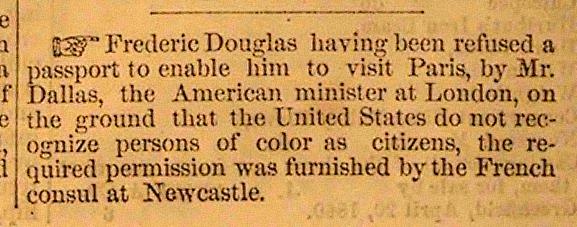Send an E-Postcard of:
Frederick Douglas refused passport

(c) Pocumtuck Valley Memorial Association, Deerfield MA. All rights reserved.
Contact us for information about using this image.
Frederick Douglass (his name is misspelled "Douglas" here) was born into slavery in Maryland. His successful escape to freedom led to his meeting William Lloyd Garrison who hired him to speak against slavery. Douglass' eloquent denunciations of slavery made him one of the most effective proponents of abolitionism. In 1859, Douglass fled from the United States in the wake of John Brown's abortive raid on Harper's Ferry. Brown had approached Douglass looking for his support. Douglass had secretly helped raise funds and helped plan the raid, but refused to join Brown when he realized how poorly conceived the raid was. Nonetheless, Brown kept all the correspondence between them and as a result Douglass, fearing arrest, fled first to Canada and then to England. There, as this news report notes, the ambassador refused to give him permission to go on to France. He did so using the reasoning from the Supreme Court decision in the case of Dred Scott (1857). Chief Justice Roger Taney wrote that "Negroes of African descent," regardless of whether they were slaves or not, could not be citizens of the United States. Although this ruling was widely ignored, it remained in effect until the Fourteenth Amendment was passed in 1868. Frederick Douglass returned to the United States in late 1860 and was not prosecuted. He became an effective spokesmen for African-Americans. He was instrumental in persuading Abraham Lincoln to order the emancipation of the slaves, something he did in his Emancipation Proclamation of 1863.
top of page
|
|





